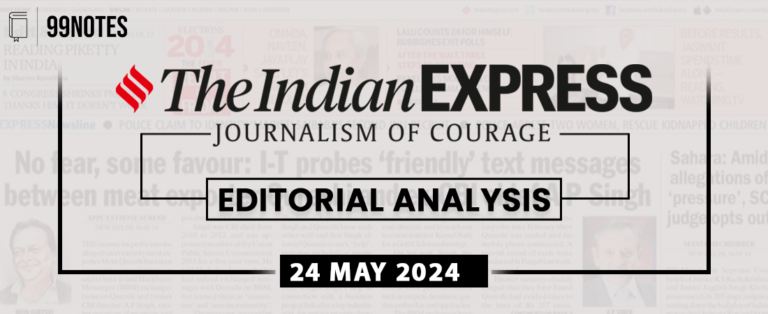27 Dec 2023 : Indian Express
Indian Express
27- December-2023
1. Seeing the new South Asia
| Topic: GS2 – International Relations This topic is not much relevant in the context of Prelims but more for Mains in the context of South Asia’s geopolitical landscape, historical context, and current challenges. |
| Context: |
|
Legacy of British Raj and Changing Realities:
- The idea that India is becoming less influential in South Asia stems from nostalgia for the British Raj era.
- But since then, the subcontinent was divided along religious lines, and the British left, changing the geopolitical landscape and leaving behind long-lasting legacy of boundary disputes.
Regional Challenges and Unresolved Issues:
- One of the long-standing issues is Kashmir, which Pakistan sees as an unfulfilled Partitionist dream.
- Regional collaboration has been hampered by border securitization and economic division, notwithstanding intermittent attempts in the age of globalisation.
Economic Cooperation and Regional Challenges:
- Even though there has been an increase in regional economic cooperation during the 1990s, Pakistan is still hesitant to do business with India.
- Although the article acknowledges that things could change under Nawaz Sharif’s leadership, it doubts that this would actually happen.
Shifts in Power Dynamics:
- Changes in power dynamics are covered in the analysis, both internally and externally.
- The British Raj’s instilled respect for Delhi among the elites of the region is beginning to wear thin as other countries come to terms with India’s limits.
- Neighbours view India’s regional aspirations as a pretext for regional hegemony, and neither dovish nor hawkish strategies succeed in addressing fundamental structural issues.
External Influences and Changing Geopolitics:
- India faces challenges from China’s growing military and economic influence in South Asia as well as the growing influence of Middle Eastern nations.
- India’s geopolitical strategy needs to be reevaluated in light of the West’s diminishing influence in the Subcontinent and the rising power of external countries like China, Qatar, Saudi Arabia, Turkey, and the UAE.
Conclusion:
- The necessity for India to let go of outdated ideas and embrace a South Asia that is evolving is emphasised in the conclusion.
- It implies that India can adjust to the changing geopolitical environment in the area and use its strengths to both maintain and increase its influence.
- The emphasis should move from the fixation with the pre-colonial South Asia to strategies for gaining ground in an area that is undergoing rapid change.
| PYQ: China is using its economic relations and positive trade surplus as tools to develop potential military power status in Asia’. In the light of this statement, discuss its impact on India as her neighbour. (UPSC CSE (M) GS-2 2017) (150 words/10 m) |
| Practice Question: Examine the evolving geopolitical landscape in South Asia, considering historical legacies and contemporary factors. (150 words/150 m) |
2. A missing industrial policy
| Topic: GS3 – Industrial Policy This topic is not much relevant in the context of Prelims but more for Mains in the context of Significance of Make in India in Transforming Indian Economy. |
| Context: |
|
Historical Context:
- It is unjustified to draw comparisons with the protectionist measures of the 1970s.
- Instead of focusing on self-sufficiency, MII has a different philosophy, aiming for global competitiveness.
- The previous protectionist policies created difficulties for consumers and distorted markets by causing shortages, illegal markets, and rent-seeking.
Key Objectives of MII:
- The 2014 launch of MII expands on past efforts to support the manufacturing industry.
- Its objectives include becoming India a centre for global manufacturing, raising the industry’s GDP share, and creating 100 million new employment. But reaching these lofty goals hasn’t always been easy.
Concerns and Criticisms:
- Even though MII has several variants, such as “Make for India” and “Made in India,” protectionism is a worry, particularly for some industries.
- Critics claim that concentrating on a sizable home market is insufficient to replace global competitiveness, which is necessary for long-term economic expansion.
Recent Developments:
- The Production-Linked Incentive (PLI) programme is now in place, and the proposed new industrial policy (NIP ’23) has been placed on hold.
- PLI seeks to increase global competitiveness in important areas, guarantee efficiency, and draw investments.
- Still, there are concerns over the industrial policy’s overall formulation and its contribution to the creation of high-quality jobs.
The Need for Labor-Intensive Manufacturing:
- It is imperative to tackle the labour market difficulties in India, which are typified by informal and low-paying jobs.
- More than 99 percent of MSMEs in India are in the unorganised sector, where there is little room for growth in terms of jobs.
- A thorough investigation is made more difficult by the lack of regular and comprehensive data regarding PLI’s impact.
Recommendations for Future Policy:
- Although high-end manufacturing is important, mass employment generation depends on labor-intensive industrial sectors.
- It is imperative that policymakers persist in promoting excellence in industries that hold promise for creating substantial job opportunities.
- A flexible and sophisticated approach to policy is needed to address the opportunities and problems brought about by the changing industrial landscape.
Conclusion:
- The Make in India initiative, which emphasises global competitiveness, diverges from previous protectionist measures.
- But its ability to accomplish economic goals—particularly the creation of jobs remains under constant examination, demanding a methodical and data-driven approach to policymaking.
| Four Pillars of Make in India |
New Processes:
New Infrastructure:
New Sectors:
New Mindset:
|
| PYQ: “Success of ‘Make in India’ program depends on the success of ‘Skill India’ programme and radical labour reforms.” Discuss with logical arguments. (UPSC CSE (M) GS-3 2015) (200 words/12.5m) |
| Practice Question: Critically analyze the evolution and impact of the Make in India (MII) campaign, highlighting its departure from historical protectionist policies. (150 words/10 m) |
For Enquiry

27 Dec 2023 : Indian Express

27 Dec 2023 : Daily Current Affairs

27 December 2023 : The Hindu Editorial Notes PDF

27 Dec 2023 : PIB

26 Dec 2023 : Daily Answer Writing

26 Dec 2023 : Daily Quiz

26 Dec 2023 : Indian Express

26 Dec 2023 : PIB

26 December 2023 : The Hindu Editorial Notes PDF

26 Dec 2023 : Daily Current Affairs
december 2023 indian express 27 Dec 2023 : Indian Express Indian Express
27- December-2023
1. Seeing the new South Asia
Topic: GS2 – International Relations
This…
Daily Current Affairs 27 Dec 2023 : Daily Current Affairs Daily Current Affairs
27-December-2023
1. INS Imphal inducted into the Navy: Its features, combat capabilities
Topic:…
December 2023 The Hindu 27 December 2023 : The Hindu Editorial Notes PDF The Hindu Editorial
27-December-2023
1. The outlook for 2024, for the world and India.
Topic: GS2…
December 2023 Pib 27 Dec 2023 : PIB PRESS INFORMATION BUREAU
27-December -2023
1. 2023 Year End Review for Department for Promotion of Industry…
mains answer writing 26 Dec 2023 : Daily Answer Writing Mains Answer Writing
26-December-2023
Q1) “World War I was an inevitable catastrophe waiting to happen,…
Daily Quiz 26 Dec 2023 : Daily Quiz 26 Dec 2023 : Daily Quiz…
december 2023 indian express 26 Dec 2023 : Indian Express Indian Express
26- December-2023
1. The Pir Panjal challenge
Topic: GS3 – Internal Security- Security…
December 2023 Pib 26 Dec 2023 : PIB PRESS INFORMATION BUREAU
26-December -2023
1. On the occasion of Good Governance Day, Union Minister…
December 2023 The Hindu 26 December 2023 : The Hindu Editorial Notes PDF The Hindu Editorial
26-December-2023
1. Article 370 issue closed, but terror victims need closure.
Topic:…
Daily Current Affairs 26 Dec 2023 : Daily Current Affairs Daily Current Affairs
26-December-2023
1. GRAP stage 3 back in force as Delhi’s air quality nosedives…




